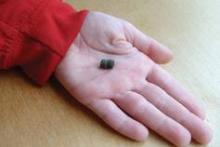Magnetic foreign body–related injuries increased significantly between 2002 and 2012, particularly those involving multiple magnet ingestion, according to a retrospective study.
"With the advent of stronger neodymium-iron-boron magnets and their inclusion as part of children’s toys, jewelry, and desk toys, there has been a documented increased in the number of cases resulting in serious morbidity and in rare cases, mortality," Dr. Matt Strickland of the Hospital for Sick Children, Toronto, and his associates, said in a report published online in the Journal of Pediatrics.
In a chart review of electronic emergency department (ED) records from a single urban tertiary site between April 1, 2002 and December 31, 2012, of 2,722 patients aged 18 years or younger, 94 were admitted for suspicion of magnet ingestion. In 75 (3%) patients, magnet ingestion was confirmed after removal or by a combination of history and imaging.
In 2010, shortly after smaller, more powerful magnets, often sold in multiples, were introduced to the marketplace, the incidence rate ratio (IRR) of magnet-related injuries increased by a factor of 2.94 (95% confidence interval, 1.84-4.70). Injuries involving multiple magnets increased by a factor of 8.40 (95% CI, 3.44-20.56). Of the confirmed ingestions, 65% were male, with a median age of 4.6 years. The volume of the magnets decreased from 878.6 mm3 to 259.8 mm3 during the years studied, as measured by radiography (P = .04), they reported (J. Pediatr. 2014 May 8 [doi:10.1016/j.jpeds.2014.04.002]).
Dr. Strickland and his associates noted that multiple magnets "pose the unique danger of being able to attract each other through different loops of bowel, arresting their movement, and potentially causing mural pressure necrosis." Six of the cases recorded in the study required the surgical removal of magnets because of intraabdominal sepsis or suspected imminent bowel perforation. Ten cases required endoscopic removal of magnets. Multiple magnet ingestion also can result in fistulas, volvulus, obstruction, and even death, although no deaths were recorded in this study.
Study limitations of note include the possibility that, after 2010, media attention and recalls of products with the magnets might have heightened public sensitivity to the dangers of magnet ingestion, driving up the number of patients admitted to the ED in the latter years of the study period.
The authors of this study did not declare any conflicts of interest.
On Twitter @whitneymcknight

